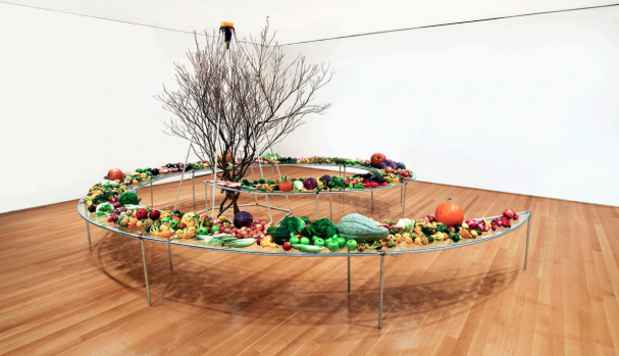Mario Merz “Works from the 1980s”
Sperone Westwater

[Image: Mario Merz "Tavola a spirale" (Spiral table) (1982)]
This event has ended.
Sperone Westwater presents an exhibition of vintage paintings and sculptures by Italian artist Mario Merz (1925-2003), a widely recognized leader of the Arte Povera movement. This solo show is the ninth of Merz’s work at the gallery since 1979, and features works from the early 1980s in a number of the artist’s best known formats: notably tables, shelters, and expansive unstretched canvases that incorporate three-dimensional attachments. The works on view demonstrate Merz’s expressive range and central thematic concerns such as issues of natural history, energy and growth, and sustenance and shelter. Through the integration of industrial and organic materials, the displayed works suggest a vibrant interplay between human and animal realms.
Merz’s work is heavily informed in both form and content by the logic of the Fibonacci sequence of numbers – the mathematic sequence in which each integer is determined by the sum of the two preceding numbers. This sequence finds symbolic expression in the spiral form that recurs throughout Merz’s work. Tavola a spirale (Spiral table), 1982, ties the sense of natural profusion directly to the table’s symbolic importance as a place of gathering. Fresh fruits and vegetables are arranged on these tables, at times massed into bountiful piles, at times organized into neat patterns.
Merz incorporates these natural networks to relate both literally and metaphorically to issues of social organization. “Because the Fibonacci numbers were progressive, and each was incorporated in the next, Merz felt they aptly expressed the relationship between a single unit and a mass, between the individual and society at large,” notes an Albright-Knox catalogue of the artist’s work. Merz saw the Fibonacci sequence as framework through which the described growth pattern of certain forms of life allows the world to become increasingly clearer.
In Quattro tavole in forma di foglie di magnolia (Four tables in the shape of magnolia leaves),1985, natural beeswax forms the surface of the welded steel from which various organic and manmade elements are suspended. The tables themselves assume the shape of magnolia leaves, which grow according to a Fibonacci progression, and suggest, like the Tavola a spirale, a potentially endless proliferation. With their constantly changing elements, Merz’s tables are perhaps the most radically open of the artist’s works, and gesture toward the broader sense of community the artist sought to engender.
The wide range of materials, forms, and concepts employed in Merz’s work also suggests a nomadic association to nature. Bisonti (Bison),1982, a canvas spanning more than 19 feet, depicts two bison beneath a colorful arc bearing the faintly scrawled line; the artist states “Se la forma scompare, la sua radice è eternal (If the form vanishes, its root is eternal).” Merz extends the bison’s hooves below the canvas to enter the space of the viewer, which upon closer inspection emerge as painted shoeboxes. An even larger untitled painting from 1983 has a more diffuse sense of animal energy, its leaf-like or wing- like forms expand outward from the edges of the canvas, snaking along the large wall it occupies. According to Merz these paintings “have something ancient about them, a sense of the unknown, of unavailability” that exhibit a juxtaposition of vernacular objects with timeless subject matter.
In Noi giriamo intorno alle case o le case girano intorno a noi? (Do we surround the houses or do the houses surround us?), 1982, vellum paintings with vivid yet ambiguous animal motifs are mounted on bamboo poles in the form of a lantern-like primitive structure. Anchored to the ground by clay feet, the work opens outward to embrace the conditions of its own display, expressing Merz’s notion that “painting is a thingly process, not subject to photographic consumption.”
Mario Merz was born in Milan on 1 January, 1925. During World War II he abandoned pursuit of a degree in medicine to join the anti-fascist movement “Giustizia e Libertà” (Justice and Freedom). Merz’s first solo museum show in the United States was at the Walker Art Center in 1972, followed by a retrospective at the Guggenheim Museum in 1989, and a survey at MoCA, Los Angeles, also in 1989. Major exhibitions of the artist’s work include Museum Folkwang, Essen (1979), Stedelijk van Abbemuseum, Eindhoven (1979), Whitechapel, London (1980), Kunsthalle, Basel (1975, 1981), Palazzo dei Congressi, San Marino (1983), Kunsthaus, Zurich (1985), Castello di Rivoli Museum of Contemporary Art (1990), and the Gallerie dell’Academia, Venice (2015). Merz’s numerous honors included the Laurea honoris causa (2001) and the Praemium Imperiale (2003). His work can be found in numerous public and private collections worldwide.
Media
Schedule
from April 30, 2016 to June 18, 2016
Opening Reception on 2016-04-29 from 17:00 to 19:00